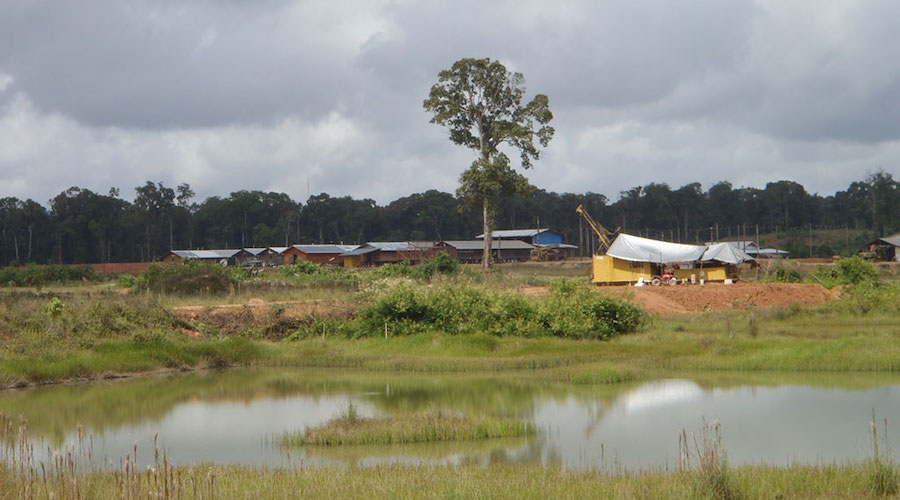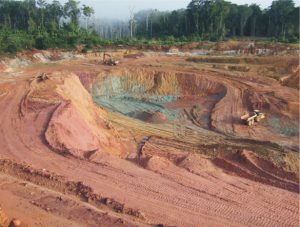Sandspring Resources (TSXV: SSP; US-OTC: SSPXF) is putting the finishing touches on a preliminary economic assessment (PEA) for its Toroparu gold project in Guyana that rescopes the project’s prefeasibility study (PFS), and includes a third gold pit. It aims to table the study in a couple of months.
“All we’re really doing is building this same concept, the same conceptual operating plan that we had in 2013–2014 — we’re just building it in two separate phases,” Sandspring CEO Rich Munson says in an interview with The Northern Miner.
Sandspring tabled its PFS in 2013, outlining a US$691-million, after-tax net present value (NPV) at a 5% discount rate, and a 23.1% after-tax internal rate of return (IRR) at US$1,400 per oz. gold, but with a US$464-million, pre-production initial capital expenditures (capex).
The company went public in 2009 after working in Guyana since the late 1990s as ETK. In the 80s and 90s, it was the largest uranium producer in the United States.
It built a 260 km road from a deepwater port to the project and drilled out a resource before realizing it needed to take the company public to keep advancing the project.
After its PFS, the company signed a precious metals streaming agreement with Wheaton Precious Metals (TSX: WPM; NYSE: WPM). Wheaton bought 10% of the project’s life-of-mine gold production at US$400 per oz. gold and half of its silver production at US$3.90 per oz. silver for a US$15.5-million early deposit that Sandspring has already received, and US$138 million in project installments.

Sandspring Resources’ Toroparu gold project in Guyana. Photo by Sandspring Resources.
The deal finances 30% of the project, although Munson says the two companies will have to “readjust the parameters of the amount of money they’ll be bringing,” because Wheaton’s contribution was based on a larger capex. That said, he thinks “they’ll bring a pro-rata amount that’s about the same.”
Development at Toroparu stalled during the market downturn. In 2015 the company survived by Munson drawing down on his home equity line of credit to advance money to Sandspring. That same year, Frank Giustra came in and took a 9.3% position in the company. With his help, the company raised enough money to drill some satellite targets.
“We’ve always been struggling to find a way to start this up at something less than 23,000 tonnes per day,” Munson says. “How can we get started with something small, but yet doesn’t destroy the upside of the deposit?”
Part of the problem was a copper component at the main Toroparu deposit.
“It’s not a lot. There’s about half a billion lb. copper,” Munson says. “But it’s right in the core of the deposit, so it’s very hard to start up without flotation and leach at the same time. Now with the satellite deposits, we can start up gold only at about half that rate — 11,500 tonnes per day.”
The main satellite deposit is called Sona Hill. It contains 11.7 million measured and indicated tonnes grading 1.04 grams gold per tonne for 394,000 oz. gold and 11.6 million inferred tonnes at 0.95 gram gold for 356,000 oz. gold.
The project’s resource is split between three proposed open pits — Toroparu, SE Zone and Sona Hill — with most of the tonnage and contained gold at the main Toroparu pit.
In total, the project has 252.5 million measured and indicated tonnes grading 0.91 gram gold for 7.35 million oz. gold, and 128.9 million inferred tonnes at 0.76 gram gold for 3.15 million oz. gold.

Sandspring Resources’ Toroparu gold project in Guyana. Photo by Sandspring Resources.
It also has 240.7 million measured and indicated tonnes at 0.81 gram silver and 0.08% copper for 6.28 million oz. silver and 444 million lb. copper, as well as 117.3 million inferred tonnes at 0.07 gram silver and 0.04% copper for 276,000 oz. silver and 104 million lb. copper. Sona Hill contains no copper or silver.
Sandspring plans to mine Sona Hill along with the Toroparu main pit and SE Zone simultaneously, opening up some of the higher-grade, gold-only zones around the main pit before starting an expansion phase in year five.
“The model shows that we will self-finance the expansion as well as self-finance construction of our run-of-river hydro project,” Munson says, “which is near us, and we’ve been working on it for quite a while.”
The run-of-river hydro project would net Sandspring US$500 million in power savings over the mine life. It signed a memorandum of understanding with the Guyanese government in 2013 that gives the company the exclusive right to develop the project.
The Kurupung river project would be located 50 km southwest of Toroparu and cost $120 million to $130 million to build. It would lower the company’s cash cost from US$700 per oz. gold in the PFS to US$565 per oz. gold. Combined with the Wheaton investment, it would lower Sandspring’s all-in sustaining costs from US$922 per oz. gold to less than US$800 per oz. gold.
“That run-of-river of course would replace diesel, which we would otherwise be burning for the entire life of the project,” Munson says. “It brings a really interesting green dimension.
“Even if we bring it on in year eight of this extended mine life, it still would save us about US$400 million of operating expenses, and almost eliminate our carbon foot print from the middle of the rainforest.”
The company would still rely on diesel as back-up power.
“The name Guyana in one of the Amerindian languages means land of many waters,” Munson says. “There isn’t one hydro project in this country. This would be the first commercial one.”
Last year, Gran Colombia Gold (TSX: GCM) bought 14.78% of Sandspring, with warrants that could increase its ownership to 20.83%. It holds 18% of the company. As part of its deal, it also picked up Gran Colombia’s Chicharron silver project in Colombia.
The company looks to put Chicharron into production soon. The project is located 4.4 km east of Gran Colombia’s Maria Dama processing facility. Gran Colombia confirmed high-grade silver mineralization at the project’s Guia Antigua mine in its 2017–2018 exploration program.
“It’d be small — 50 to 100 tonnes a day — but for a little company like us, it pays the bills,” Munson says. “If we don’t need that cash to pay the light bill, then we could drill with it.”
Guias Gold operated the mine from 2014–2016 reporting average grades of 466 grams silver and 7.44 grams gold. It produced 78,500 oz. silver and 1,170 oz. gold from 6,000 tonnes grading 404.9 grams silver and 6.05 grams gold.
The company mined 12 tonnes per day using non-mechanized methods. It primarily mined a 1- to 3-metre-wide quartz vein, with minor carbonate.
Sandspring acquired the project in 2018 for 36 million shares and US$1 million in cash. It recently finished an eight-hole drill program at Chicharron to determine where the vein is offset, and which direction it’s going.
“We can go to work right away because we’re included in Gran Columbia’s environmental permits,” Munson says. “Our goal is to put a contract miner in there starting the second quarter of this year, and go to work.”
Sandspring shares are trading at 24¢ in a 52-week range of 17¢ to 35¢. The company has a $49-million market capitalization.
“In what I call the days of wine and roses back in late 2013, we had a $400-million market cap, and we were trading at $4 a share,” Munson says. “Today we’re 25¢, and I still own the same shares I got in 2009.
“We’re just going to progress. We’ll go to a PEA, and then because of all the work we’ve done, we’ll go to final feasibility. There’s no need to go back to another PFS.”
This story by Richard Quarisa first appeared on www.northernminer.com.
The post Sandspring rethinks Toroparu in Guyana appeared first on MINING.com.
